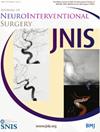Acquisition of Prehospital Stroke Severity Scale is associated with shorter door-to-puncture times in patients with prehospital notifications transported directly to a thrombectomy center
IF 4.5
1区 医学
Q1 NEUROIMAGING
引用次数: 0
Abstract
Background We sought to identify systemic factors influencing door-to-puncture times (DTP) among patients with pre-arrival notifications presenting directly to a comprehensive stroke center (CSC) and undergoing emergent mechanical thrombectomy (MT). Methods In this retrospective analysis of a prospectively maintained registry of acute ischemic stroke (AIS) patients undergoing MT at two CSCs between January 2021 and October 2023, we included consecutive AIS patients presenting directly to the CSC with pre-arrival notifications via emergency medical services (EMS) and who underwent emergent MT. We excluded patients with known confounders to DTP and divided this cohort into two groups: DTP ≤75 min and >75 min. We used variables with P value <0.2 in the univariate analysis to build a binary logistic regression model to identify their association with DTP >75 min, adjusting for door-to-CT time. Results Of 900 patients, 605 were inter-facility transfers, 89 were excluded due to known confounders/missing prehospital notifications, leaving 206 qualifying patients. On multivariable analysis, not meeting American Heart Association (AHA) level 1 criteria (adjusted OR (aOR) 3.04, 95% CI 1.62 to 5.82, P<0.001), lack of Prehospital Stroke Severity Scale (PSSS) acquisition (aOR 2.2, 95% CI 1.19 to 4.11, P=0.01), and presentation after-hours (aOR 2.27, 95% CI 1.23 to 4.28, P=0.01) were associated with >75 min DTP times. Most patients (62.3%) had no clearly documented reasons for delay in MT, whereas 25.8% of delays were attributed to prolonged medical decision-making. Conclusion Arrival outside business hours, not meeting AHA level 1 criteria, and lack of PSSS acquisition by EMS were associated with prolonged DTP. Impacting modifiable factors such as prehospital assessment of stroke severity is an optimal target for quality improvement. Data are available upon reasonable request. Data supporting the findings of this study will be made available upon reasonable request.获得院前卒中严重程度量表与缩短直接送往血栓切除中心的院前通知患者的门到穿刺时间有关
背景 我们试图确定影响直接前往综合卒中中心(CSC)并接受紧急机械取栓术(MT)的患者到达前通知的门到穿刺时间(DTP)的系统性因素。方法 在这项对 2021 年 1 月至 2023 年 10 月期间在两家 CSC 接受机械取栓术的急性缺血性卒中(AIS)患者前瞻性登记的回顾性分析中,我们纳入了通过紧急医疗服务(EMS)直接到达 CSC 并接受紧急机械取栓术的连续 AIS 患者。我们排除了与 DTP 存在已知混杂因素的患者,并将该队列分为两组:DTP ≤75 分钟和 >75 分钟。我们使用了 P 值为 75 分钟的变量,并对从门到 CT 的时间进行了调整。结果 在900名患者中,有605名是医院间转院,89名因已知混杂因素/院前通知缺失而被排除,剩下206名符合条件的患者。经多变量分析,不符合美国心脏协会(AHA)1级标准(调整后OR(aOR)为3.04,95% CI为1.62至5.82,P75分钟DTP时间)的患者(62.3% CI为1.62至5.82,P75分钟DTP时间)占所有符合条件的患者总数的1%。大多数患者(62.3%)没有明确记录延误 MT 的原因,而 25.8% 的延误是由于医疗决策时间过长。结论 在工作时间以外到达、不符合 AHA 1 级标准以及急救服务未获取 PSSS 与 DTP 时间延长有关。影响院前中风严重程度评估等可改变的因素是质量改进的最佳目标。如有合理要求,可提供相关数据。如有合理要求,可提供支持本研究结果的数据。
本文章由计算机程序翻译,如有差异,请以英文原文为准。
求助全文
约1分钟内获得全文
求助全文
来源期刊

Journal of NeuroInterventional Surgery
NEUROIMAGING-SURGERY
CiteScore
9.50
自引率
14.60%
发文量
291
审稿时长
4-8 weeks
期刊介绍:
The Journal of NeuroInterventional Surgery (JNIS) is a leading peer review journal for scientific research and literature pertaining to the field of neurointerventional surgery. The journal launch follows growing professional interest in neurointerventional techniques for the treatment of a range of neurological and vascular problems including stroke, aneurysms, brain tumors, and spinal compression.The journal is owned by SNIS and is also the official journal of the Interventional Chapter of the Australian and New Zealand Society of Neuroradiology (ANZSNR), the Canadian Interventional Neuro Group, the Hong Kong Neurological Society (HKNS) and the Neuroradiological Society of Taiwan.
 求助内容:
求助内容: 应助结果提醒方式:
应助结果提醒方式:


